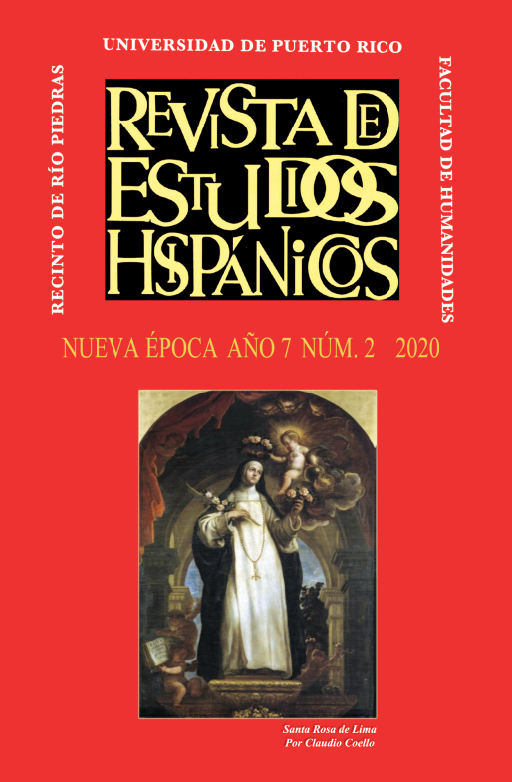Abstract
Pawns of a House, by Sister Juana Inés de la Cruz, has generally been studied from feminist or gender theory perspectives. However, it is a play in which female characters evoke the medieval ideology about women, as they are portrayed as deceiving, prone to evil and sexually uncontrollable; characteristics inherited from Eve. With this in mind, this paper reevaluates Sister Juana Inés’s comedy in order to show that the author presents her orthodox thinking throughout the text’s female characters. We will engage with the critical works of Gerda Lerner, Susana Hernández Araico, and Stephanie Merrim, among others, as an argumentative basis. Additionally, we will use literary, theological and philosophical examples to explore the definition of a Medieval woman, as well as how this definition is represented through the comedy’s female characters. Finally, we will show how these women redeem themselves at the end of the work and restore the order of broken honor.
References
Abram, Simón, editor. La Iglesia Católica Romana de la Biblia en español. Edición digital, ISBN: 9781937485139.
Anderson Imbert, Enrique y Eugenio Florit. Literatura hispanoamericana. Antología e introducción histórica. Holt, Rinehart and Winston, 1960, 125-126.
Chang-Rodríguez, Raquel. «Relectura de Los empeños de una casa». Revista Iberoamericana, vol. 44, no. 104, 1978, 409-419.
Chevalier, Jean, and Alain Gheerbrant. The Penguin Dictionary of Symbols. Translated from the French by John Buchanan-Brown, Penguin Books, 1996, 529-531.
Cirlot, Juan-Eduardo. Diccionario de símbolos. Editorial Labor, 1992.
Cooper, J. C. An Illustrated Encyclopaedia Of Traditional Symbols. Thames and Hudson Ltd, 1978, 86.
Domínguez Quintana, Rubén. «La seducción en Los empeños de una casa o cómo subvertir los espacios del deseo». OGIGIA. Revista electrónica de estudios hispánicos, vol. 7, 2010, 9-71.
Fradejas Lebrero, José, editor. Sendebar. Libro de los engaños de las mujeres. Editorial Castalia, 1990.
Ficek, Jerome L. “The Paradox of the Fortunate Fall in Contemporary Theology”. Bulletin of the Evangelical Theological Society, vol. 2, no. 3, 1959, 1-7.
Hernández Araico, Susana. “Los empeños de una casa. Staging gender”. The Routledge Companion to the Works of Sor Juana Inés de la Cruz, edited by Emilie L. Bergmann and Stacey Schlau, Routledge, 2017, 564-586.
Hettinger, Madonna J. “Household Management”. Women and Gender in Medieval Europe. An Encyclopedia, edited by Margaret Schaus, Routledge, 2006, 380-381.
Lemus, George. «El feminismo de Sor Juana Inés de la Cruz en “Los empeños de una casa”». Letras Femeninas, vol. 11, no. 1/2, 1985, 21-29.
Lerner, Gerda. The Creation of Feminist Consciousness. From the Middle Ages to Eighteen-seventy. Oxford University Press, 1993.
MacLehose, William F. “Aristotelian Concepts of Women and Gender”. Women and Gender in Medieval Europe. An Encyclopedia, edited by Margaret Schaus, Routledge, 2006, 35-36.
Manuel, Juan. El conde Lucanor. Edición de Enrique Moreno Báez, Editorial Castalia, 1996.
Merrim, Stephanie. “Mores Geometricae: The ‘Womanscript’ in the Theater of Sor Juana Inés de la Cruz”. Feminist Perspectives on Sor Juana Inés de la Cruz, edited by Stephanie Merrim, Wayne State University Press, 1991, 94-123.
Messinger Cypess, Sandra. «Los géneros re/velados en “Los empeños de una casa” de Sor Juana Inés de la Cruz», Hispamérica, vol. 22, no. 64/65, 1993, 117-185.
Morino, Angelo. «El teatro de sor Juana Inés de la Cruz». Historia de la cultura literaria en Hispanoamérica i, de Dario Puccini y Saúl Yurkievich, Fondo de Cultura Económica, 2010, 78-383.
Poot Herrera, Sara. «Atrapados sin salida: de nuevo Sor Juana en Los empeños de una casa». América sin Nombre, no. 21, 2016, 107-116.
Quevedo, Francisco de. «Definiendo el amor». Poesía varia, edición de James O. Crosby, Cátedra, 2014, 491.
Rabell, Carmen Rita. «Los empeños de una casa: Una re-escritura femenina de la comedia de enredo del Siglo de Oro español». Revista de Estudios Hispánicos, no. 22, 1993, 11-25.
Ruiz, Juan. Libro de buen Amor. Edición de María Brey Mariño, Editorial Castalia, 1995.
Sabat de Rivers, Georgina. En busca de sor Juana. Biblioteca Virtual Universal, 55-64.
Spivey Ellington, Donna. “Eve”. Women and Gender in Medieval Europe. An Encyclopedia, edited by Margaret Schaus, Routledge, 2006, 266-267.
Urrutia, Jorge. «Estructura de la significación en Los empeños de una casa, de sor Juana Inés de la Cruz». Philología Hispalensis, vol. 4, no. 1, 1989, 407-415.
Vega, Lope de. «Desmayarse, atreverse, estar furioso». Poesía selecta. Antonio Carreño (ed.). Cátedra, 2010, 254.

This work is licensed under a Creative Commons Attribution-NonCommercial 4.0 International License.

